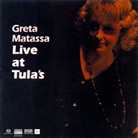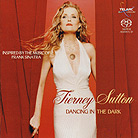June 2004
Greta Matassa was something of a newcomer to my jazz-singer consciousness, though it appears she’s been a staple of the jazz scene in the Washington/Oregon area for quite some time. Live at Tula’s was recorded at a popular Seattle jazz club in December of 2003 by David Keefer and Paul Wietzel, and mastered by David Glasser at Air Stream Mastering. Backed by her bandmates, pianist Randy Halberstadt, bassist Clipper Anderson, and drummer Gary Hobbs, Matassa is captured in a very conducive atmosphere where her way with both the songs and the crowd are fully realized. While there is nothing new or innovative on Live at Tula’s, you'll find plenty to capture and hold your attention. Matassa sticks pretty much to songs taken from the Great American Songbook, and her understanding of each tune, along with the superb delivery, make this disc more than a recording by a little-known jazz singer. On this disc Matassa demonstrates that just because you choose to make a career in one location (due to maybe nothing more than that she just likes the area), it doesn’t mean that you don’t have talent, or deserve to have that talent recognized. Greta Matassa has a wonderful voice, a way with phrasing, and a purpose to her improvisations, together with an understanding of what it takes to get her audience excited. Another salient point to Live at Tula’s is just how well it captures the feel of being inside the club, with a table in the front row, surrounded by the crowd, listening to a singer supported by a trio of sympathetic musicians. This album catches that mood and transmits it very, very well. If I closed my eyes, I could easily imagine being transported to Tula’s. And while this was true no matter which format I listened to (stereo CD, stereo SACD, or multichannel SACD), it was really brought to the fore in the multichannel mix. There, Matassa and company are spread out before you, with plenty of space between and around them. The crowd noise comes from all about your listening position. Keefer really captured the feel of that night on Live at Tula’s, and that goes a long way toward making this disc highly enjoyable. Dancing in the Dark, the latest from L.A.-based Tierney Sutton, is a different kettle of fish entirely. This album is Sutton’s fourth for Telarc, but marks a move away from the style of her previous three. Dancing in the Dark is more of a concept album, being based, as it is, on songs that Ms. Sutton associates with one of her main inspirations, Francis Albert Sinatra. Pianist Christian Jacob, bassist Trey Henry, and drummer Ray Brinker, the trio that has been with her since her 1999 recording debut, Introducing Tierney Sutton, back her here. Sutton adds orchestration, under Jacob's baton, to a few tracks. The interplay that comes from having played together several years is fully evident on Dancing in the Dark. Each player can anticipate where his bandmates will head, and meet him there, right on time. It’s this familiarity that aids in making this disc the success it is. Of the 12 tracks recorded here (giving this disc a full 55+ minutes of playing time), I could only find four that I immediately associate with Ol’ Blue Eyes. But as Sutton points out in the very well-written and informative liner notes, she wasn’t aiming at making this album a greatest-hits package. Instead, she looked into "the dark corners of his work that I (found) endlessly compelling. That’s why the song selection may not seem to be very "Sinatra" at first glance. These songs are about my personal relationship with Sinatra -- they’re the ones which tell the story of our affair." And I have to say, I found this method for choreographing an album compellingly insightful. It really helped hold my attention. Another plus in choosing less-familiar songs is that Sutton is not trapped into singing just as Sinatra did. Instead, she is free to interpret each song, making it hers, not a hand-me-down. And, for Sinatraholics, attention is held by Ms. Sutton’s way with each tune. I especially enjoyed her rendition of "I Could Have Told You" where the wistfulness she implies in her singing is mesmerizing. The sound given Dancing in the Dark by recording engineer Michael Bishop stands in complete opposite of that on Live at Tula’s. Sutton’s album is very definitely a studio job. The soundstage is speaker-to-speaker (even that of the orchestra). There is a more sterile feel -- a squeaky cleanness if you will -- to this presentation. But this method allows the listener to concentrate fully on Tierney Sutton’s voice, which is all to the good, as she’s got a superb set of pipes. And, as is usual from Telarc, the CD, stereo SACD and multichannel SACD layers are each wondrous in turn. The multichannel mix uses the rear speakers for ambience only, no swirl of instruments to bother your sensibilities. On both these discs, the superiority of the SACD layer, stereo or multichannel, over that of the CD is markedly demonstrated. And yet it does not in the least invalidate the quality given to the CD layer for those who have not yet converted to high-resolution digital. You do not have to own an SACD player to get full appreciation for either of these wonderful recordings -- though it will help if you do. As I noted in another review of two female jazz vocalists a few months back, this particular segment of the jazz marketplace seems to be holding its own in the face of the malaise that continues to paralyze the recording industry in general, and jazz in particular. And while we do not have a jazz vocalist of the caliber of Billie Holiday, Ella Fitzgerald or Carmen McRae around today, the genre is still held in very capable, if more diverse, hands. Both Greta Matassa and Tierney Sutton hold the flame of jazz singing high. And both these albums bear witness that while the present is fine, the future looks very bright indeed. GO BACK TO: |
 Greta Matassa - Live at
Tula's
Greta Matassa - Live at
Tula's Tierney
Sutton - Dancing in the Dark
Tierney
Sutton - Dancing in the Dark It wasn’t all
that many years ago when if you were a jazz singer, or a jazz musician for that matter,
New York City, with it myriad of jazz clubs on 52nd St., was the place to be if you
wanted to play with the worlds best jazzmen and become a star in your own right. Also, the
NYC area was the location of most of the finest jazz labels, so it was far easier for
Mohammad to go to the mountain. But times change, and so does the world of recorded jazz.
These days, one can find quality jazz being played everywhere from Portland, Maine to
Portland, Oregon, and all points in between. This review will consider discs from Greta
Matassa, who calls the Pacific Northwest home, and Tierney Sutton, an L.A. teacher and
chanteuse.
It wasn’t all
that many years ago when if you were a jazz singer, or a jazz musician for that matter,
New York City, with it myriad of jazz clubs on 52nd St., was the place to be if you
wanted to play with the worlds best jazzmen and become a star in your own right. Also, the
NYC area was the location of most of the finest jazz labels, so it was far easier for
Mohammad to go to the mountain. But times change, and so does the world of recorded jazz.
These days, one can find quality jazz being played everywhere from Portland, Maine to
Portland, Oregon, and all points in between. This review will consider discs from Greta
Matassa, who calls the Pacific Northwest home, and Tierney Sutton, an L.A. teacher and
chanteuse.